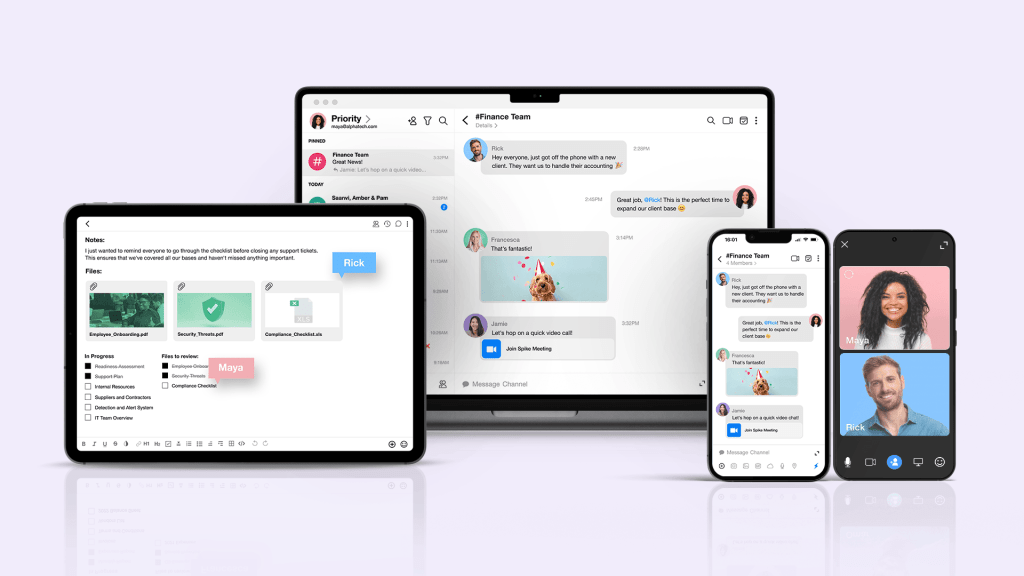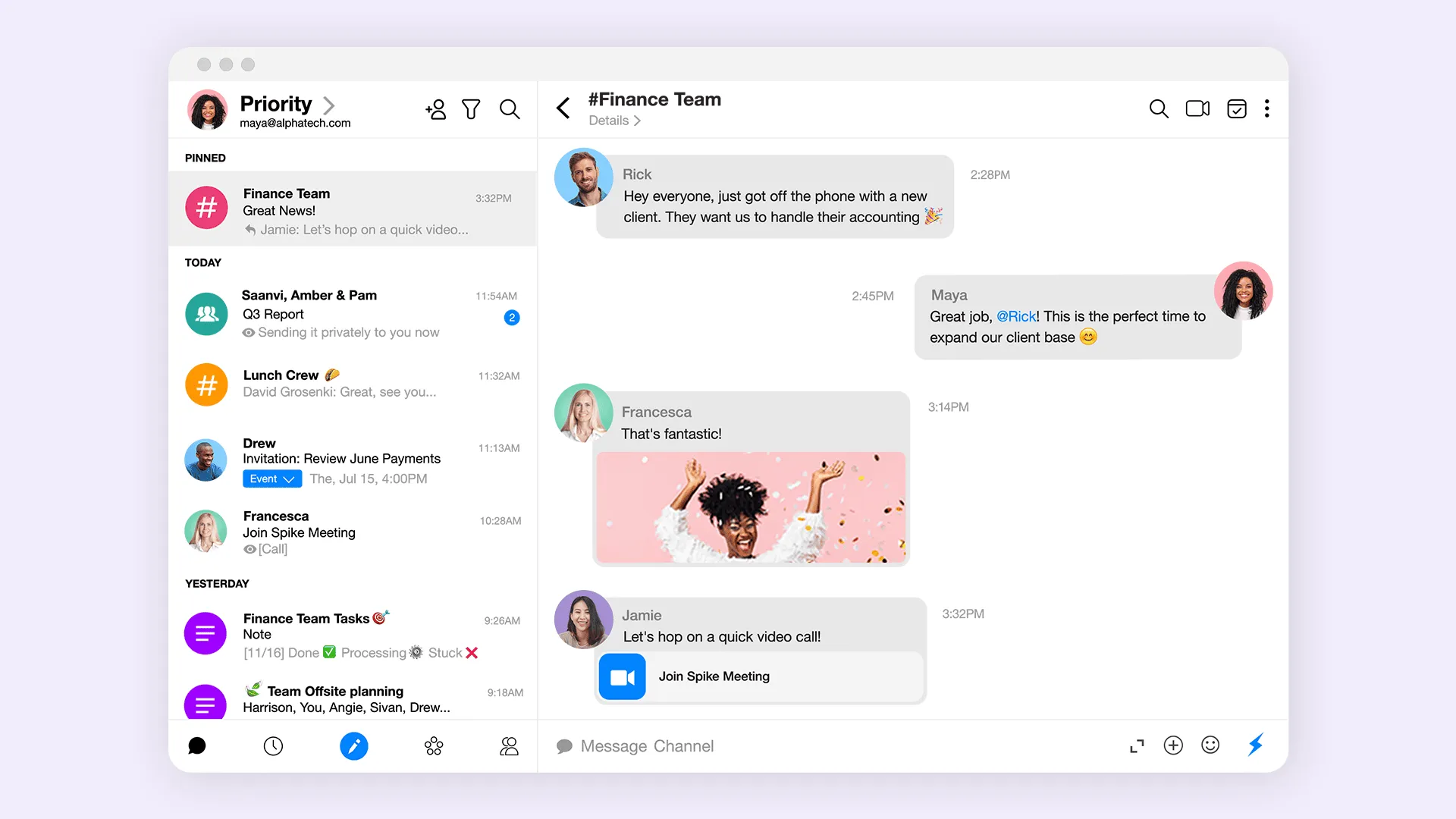Email finally evolved: Why inbox-based tools are now obsolete

You’ve tried every productivity hack and email app promising to fix your overflowing inbox.
You get that AI summary of a 20-message thread, but you still have to scroll through the entire thing to find the actual decision. You set up smart filters that sort newsletters from work emails, but you’re still hunting through three different folders to find that one message from last Tuesday. You snooze emails to deal with later, then forget what they were about when they resurface.
The fancy email clients with a gazillion integrations might chip away at minor inconveniences, but the same problems are always there: You open an email thread and immediately start mental reconstruction.
- Who said what when?
- Where’s the latest version?
- What was the actual decision?
Instead of communicating, you’re stuck doing archaeology on your own conversations.
The actual problem is email’s design, or at least how it’s always been designed until now.
Email’s fundamental design flaw
Email splits every conversation into separate messages. You get a new message for each reply, each forward, each person added to the thread. What should be one flowing conversation becomes dozens of disconnected documents scattered across time.
Every time you open a message, you’re forced to piece together what happened before. You scroll up and down, trying to remember who said what and when, hunt for the original message to understand what everyone is responding to, and then lose track of decisions made three messages ago.
This creates crushing cognitive overhead for modern work patterns. While competitors kept adding AI to help you manage this mess better, one company eliminated the mess entirely.
How Spike eliminated the problem instead of managing it

Most email clients add features to help you navigate the mess faster. Spike got rid of the mess.
Instead of splitting conversations into separate messages, Spike shows everything as one flowing timeline. All your back-and-forth with someone appears in chronological order. Instead of hunting through scattered replies to find what someone said last week, you see everything in sequence.
Instead of scrolling up and down trying to piece together the conversation flow, the full context is right there. Instead of losing track of decisions buried in message #7 of a 12-message chain, you can follow the entire discussion from start to finish.
The conversation history is right there, in order, every time you open it. You see the full context immediately instead of reconstructing it from fragments.
When you need a summary of a long conversation, it appears at the top automatically. Action items get highlighted so nothing falls through the cracks. Messages get prioritized so important stuff doesn’t get lost in the noise.
All of this happens within the conversation flow, not in separate tools or buried menus you have to remember to check.
Reality check: If you’ve spent years building Gmail muscle memory, this feels strange at first. Your brain expects separate message documents. Takes about two weeks to adjust. Once you do, going back to traditional email feels like trying to have a conversation through a filing cabinet.
Cross-platform sync works seamlessly. Read a message on your phone, it’s marked read on your laptop instantly. Team features include shared inboxes, integrated video calling, and collaborative documents. Multiple email accounts merge into one unified inbox without confusion.
The trade off:
Learning curve exists for traditional email users. Third-party integrations remain limited compared to Microsoft’s ecosystem. But these limitations become irrelevant once you realize the benefits of communicating differently.
Of course, not everyone is ready to abandon the traditional inbox. An entire industry exists to help you manage email’s chaos more efficiently.
Understanding how the most popular tools approach this challenge reveals why they represent optimization, not evolution. Each falls into a predictable camp, perfecting solutions to the wrong problem.
Superhuman: the $30 productivity theater
Superhuman is the absolute peak of inbox-management optimization. Keyboard shortcuts for everything let you tear through traditional email faster than any other tool. The pitch is true. It’s the fastest email experience ever made.
The catch: At $30 monthly, you’re paying premium prices to remain stuck in the 1970s email structure. It helps you manage clutter with lightning speed but does nothing about the source of clutter. The threaded structure itself.
Assessment: If your job involves processing hundreds of individual email threads daily, Superhuman’s speed might justify the cost. For collaborative work, it’s an expensive way to avoid evolution.
Gmail and Outlook: when integration matters most
These are the ecosystem heavyweights. They work because everything else works with them.
Gmail: the reliable workhorse
Gmail remains solid for Google ecosystem users. Search functionality is unmatched—finding emails across years of correspondence takes seconds. Smart Compose generates entire paragraphs for routine business communications.
Gemini integration shows marked improvement over previous AI attempts.
Be warned though, Google’s data collection creates privacy concerns for sensitive communications. Storage limitations hit hard with 15GB shared across Gmail, Drive, and Photos. The advertising integration, while less obvious, still influences email organization.
Microsoft Outlook: the enterprise standard
Outlook’s Copilot integration represents Microsoft’s most successful AI implementation. It analyzes meeting transcripts, email patterns, and calendar data for relevant suggestions. Calendar integration surpasses all competitors.
Enterprise security features include advanced threat protection smaller competitors cannot match.
But, it’s loaded with features most users never touch. Navigation complexity increases with each update, making simple tasks harder. For organizations using Teams and Office 365, integration makes it indispensable.
Security-focused email with trade-offs
Proton Mail: security first, convenience second
Proton Mail implements end-to-end encryption while maintaining usability for non-technical users. AI features process data locally, avoiding cloud-based analysis that hurts privacy. Bridge software enables desktop integration while maintaining encryption.
However, the search functionality suffers because of encryption requirements. Finding specific messages requires more effort than standard email clients.
Apple Mail: ecosystem prisoner
Apple Mail excels within Apple’s ecosystem exclusively. AI features prioritize privacy through on-device processing, resulting in less sophisticated but more secure automation. Siri integration enables voice commands, though accuracy varies significantly.
Platform exclusivity eliminates consideration for anyone using Windows, Android, or Linux systems.
Feature-rich options that miss the point
Spark Mail: smart sorting on old architecture
Spark automatically categorizes emails into Personal, Notifications, and Newsletters using machine learning. Smart Inbox prioritizes important messages while filtering less urgent ones. Collaboration features include sharing and commenting on emails internally.
These are smart features built on top of the same old inbox system. The commenting feature exists only because underlying email is a static document. You’re still managing lists of messages instead of flowing conversations.
HEY: opinionated email philosophy
HEY implements specific workflow opinions through forced processes. Screening for new senders reduces spam but requires active management. Bundling groups related emails automatically, though algorithms sometimes create confusing associations.
Whether HEY improves email management depends entirely on alignment with their designers’ workflow assumptions. It’s email ideology, not email evolution.
The also-rans
Thunderbird represents open-source development challenges. Extensively customizable but feels dated. Development pace cannot match commercial competitors. New features arrive years after implementation elsewhere.
Canary Mail markets advanced security but implements inconsistently. Marketing promises exceed delivered functionality.
Both serve niche requirements but fail to justify existence against superior alternatives.
Why a conversational-design email client fits for every work style
The conversational approach works regardless of how you use email.
Processing high-volume transactions? You’ll move faster when you can see the full context of each discussion instantly instead of reconstructing it from scattered messages.
Managing ongoing collaborations? No more losing track of decisions buried in thread #12 or hunting through folders to find what someone said last week. Handling sensitive communications? End-to-end encryption works just as well in conversational flow as it does in traditional threading.
Every work style benefits when communication flows naturally instead of forcing you to do mental archaeology on your own conversations.
Traditional inbox tools ask you to choose between speed, collaboration features, or privacy protection. The conversational approach delivers all three because it eliminates the underlying inefficiencies that forced those trade-offs in the first place.
The question isn’t which email client fits your work style best. It’s whether you want to keep optimizing a broken system or switch to communication designed for how humans actually think.
Why this evolution was inevitable
Email’s architectural limitations became obvious once work shifted to continuous communication. Threading worked when messages were occasional and formal. It breaks down when communication becomes conversational and frequent.
Most current AI implementations range from useful to marketing tricks. Spike and Outlook show meaningful integration improving daily workflows. Gmail’s AI works well but lacks sophistication. Most applications add AI features to existing frameworks without thoughtful integration.
Conversational design isn’t a preference. It’s communication evolved to match how humans actually interact. The competitive advantage comes not from managing email better but from eliminating the need to manage email at all.
Organizations still optimizing inbox management will find themselves at a disadvantage against teams using communication designed for actual human interaction patterns.
Choose your solution based on whether you want to manage the 1970s communication model more efficiently or participate in its evolution beyond recognition.
The future of productivity isn’t about finding signal in noise faster. It’s about designing tools that eliminate the noise from the start.




